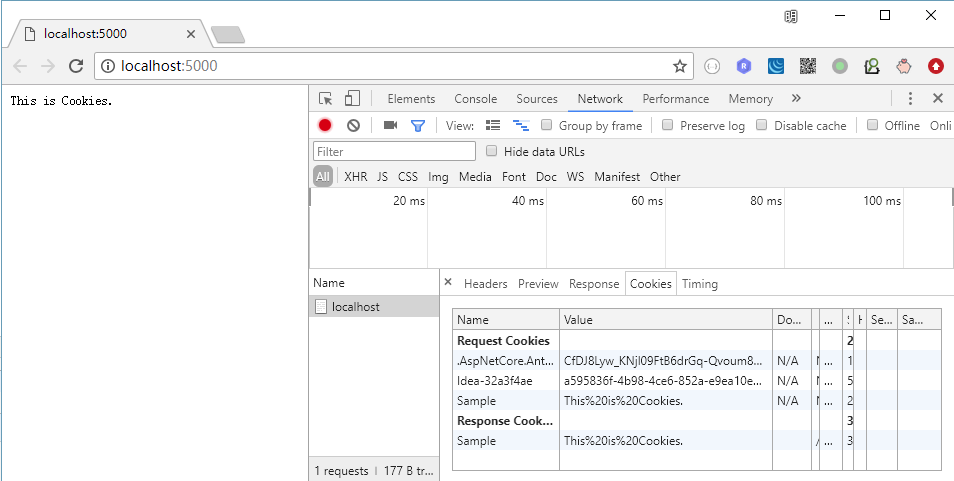基本上HTTP是没有记录状态的协定,但可以通过Cookies将Request来源区分出来,并将部分数据暂存于Cookies及Session,是写网站常用的用户数据暂存方式。
本篇将介绍如何在ASP.NET Core使用Cookie及Session。
Cookies
Cookies是将用户数据存在Client的浏览器,每次Request都会把Cookies送到Server。
在ASP.NET Core中要使用Cookie,可以通过HttpContext.Request及HttpContext.Response存取:
Startup.cs
using System;
using System.Collections.Generic;
using System.Linq;
using System.Threading.Tasks;
using Microsoft.AspNetCore.Builder;
using Microsoft.AspNetCore.Hosting;
using Microsoft.AspNetCore.Http;
using Microsoft.Extensions.DependencyInjection;
namespace MyWebsite
{
public class Startup
{
// This method gets called by the runtime. Use this method to add services to the container.
// For more information on how to configure your application, visit https://go.microsoft.com/fwlink/?LinkID=398940
public void ConfigureServices(IServiceCollection services)
{
}
// This method gets called by the runtime. Use this method to configure the HTTP request pipeline.
public void Configure(IApplicationBuilder app, IHostingEnvironment env)
{
if (env.IsDevelopment())
{
app.UseDeveloperExceptionPage();
}
// app.Run(async (context) =>
// {
// await context.Response.WriteAsync("Hello World!");
// });
app.Run(async (context) =>
{
string message;
if (!context.Request.Cookies.TryGetValue("Sample", out message))
{
message = "Save data to cookies.";
}
context.Response.Cookies.Append("Sample", "This is Cookies.");
// 刪除 Cookies 数据
//context.Response.Cookies.Delete("Sample");
await context.Response.WriteAsync($"{message}");
});
}
}
}
从HTTP 可以看到传送跟收到的Cookies 信息:

当存在Cookies 的信息越多,封包就会越大,因为每个Request 都会带着Cookies 数据。
Session
Session是通过Cookies内的唯一识别信息,把用户数据存在Server端内存、NoSQL或数据库等。
要在ASP.NET Core使用Session需要先加入两个服务:
- Session容器
Session可以存在不同的地方,透过DIIDistributedCache物件,让Session服务知道要将Session存在哪边。
(之后的文章会介绍到IDistributedCache分散式快取) - Session服务
在DI容器加入Session服务。并将Session的Middleware加入Pipeline。
Startup.cs
using System;
using System.Collections.Generic;
using System.Linq;
using System.Threading.Tasks;
using Microsoft.AspNetCore.Builder;
using Microsoft.AspNetCore.Hosting;
using Microsoft.AspNetCore.Http;
using Microsoft.Extensions.DependencyInjection;
namespace MyWebsite
{
public class Startup
{
// This method gets called by the runtime. Use this method to add services to the container.
// For more information on how to configure your application, visit https://go.microsoft.com/fwlink/?LinkID=398940
public void ConfigureServices(IServiceCollection services)
{
// 将 Session 存在 ASP.NET Core 内存中
services.AddDistributedMemoryCache();
services.AddSession();
}
// This method gets called by the runtime. Use this method to configure the HTTP request pipeline.
public void Configure(IApplicationBuilder app, IHostingEnvironment env)
{
if (env.IsDevelopment())
{
app.UseDeveloperExceptionPage();
}
// SessionMiddleware 加入 Pipeline
app.UseSession();
app.Run(async (context) =>
{
context.Session.SetString("Sample", "This is Session.");
string message = context.Session.GetString("Sample");
await context.Response.WriteAsync($"{message}");
});
}
}
}
HTTP Cookies 信息如下:

可以看到多出了.AspNetCore.Session,.AspNetCore.Session就是Session的唯一识别信息。
每次Request时都会带上这个值,当Session服务取得这个值后,就会去Session容器找出专属这个值的Session数据。
对象类型
以前ASP.NET可以将对象直接存放到Session,现在ASP.NET Core Session不再自动序列化对象到Sesson。
如果要存放对象到Session就要自己序列化了,这边以JSON格式作为范例:
ExtensionsSessionExtensions.cs
using Microsoft.AspNetCore.Http;
using Newtonsoft.Json;
namespace MyWebsite.Extensions
{
public static class SessionExtensions
{
public static void SetObject<T>(this ISession session, string key, T value)
{
session.SetString(key, JsonConvert.SerializeObject(value));
}
public static T GetObject<T>(this ISession session, string key)
{
var value = session.GetString(key);
return value == null ? default(T) : JsonConvert.DeserializeObject<T>(value);
}
}
}
通过上面扩展方法,就可以将对象存取至Session,如下:
using MyWebsite.Extensions;
using MyWebsite.Models;
// ...
var user = context.Session.GetObject<UserModel>("user");
context.Session.SetObject("user", user);
安全性
虽然Session数据都存在Server端看似安全,但如果封包被拦截,只要拿到.AspNetCore.Session就可以取到该用户数据,也是有风险。
有些安全调整建议实作:
- SecurePolicy
限制只有在HTTPS连线的情况下,才允许使用Session。如此一来变成加密连线,就不容易被拦截。 - IdleTimeout
修改合理的Session到期时间。预设是20分钟没有跟Server互动的Request,就会将Session变成过期状态。
(20分钟有点长,不过还是要看产品需求。) - Name
没必要将Server或网站技术的信息爆露在外面,所以预设Session名称.AspNetCore.Session可以改掉。
// ...
public void ConfigureServices(IServiceCollection services)
{
services.AddDistributedMemoryCache();
services.AddSession(options =>
{
options.Cookie.SecurePolicy = CookieSecurePolicy.Always;
options.Cookie.Name = "mywebsite";
options.IdleTimeout = TimeSpan.FromMinutes(5);
});
}
强类型
由于Cookies及Session预设都是使用字串的方式存取资料,弱类型无法在开发阶段判断有没有打错字,还是建议包装成强类型比较好。
而且直接存取Cookies/Session的话逻辑相依性太强,对单元测试很不友善,所以还是建议包装一下。
WappersSessionWapper.cs
using Microsoft.AspNetCore.Http;
using MyWebsite.Extensions;
using MyWebsite.Models;
// ...
namespace MyWebsite.Wappers
{
public interface ISessionWapper
{
UserModel User { get; set; }
}
public class SessionWapper : ISessionWapper
{
private static readonly string _userKey = "session.user";
private readonly IHttpContextAccessor _httpContextAccessor;
public SessionWapper(IHttpContextAccessor httpContextAccessor)
{
_httpContextAccessor = httpContextAccessor;
}
private ISession Session
{
get
{
return _httpContextAccessor.HttpContext.Session;
}
}
public UserModel User
{
get
{
return Session.GetObject<UserModel>(_userKey);
}
set
{
Session.SetObject(_userKey, value);
}
}
}
}
在DI容器中加入IHttpContextAccessor及ISessionWapper,如下:
Startup.cs
// ...
public void ConfigureServices(IServiceCollection services)
{
services.AddSingleton<IHttpContextAccessor, HttpContextAccessor>();
services.AddSingleton<ISessionWapper, SessionWapper>();
}
- IHttpContextAccessor
ASP.NET Core实现了IHttpContextAccessor,让HttpContext可以轻松的注入给需要用到的对象使用。
由于IHttpContextAccessor只是取用HttpContext实例的接口,用Singleton的方式就可以供其它物件使用。
在Controller就可以直接注入ISessionWapper,以强类型的方式存取Session,如下:
Controllers/HomeController.cs
using Microsoft.AspNetCore.Mvc;
using MyWebsite.Wappers;
namespace MyWebsite.Controllers
{
public class HomeController : Controller
{
private readonly ISessionWapper _sessionWapper;
public HomeController(ISessionWapper sessionWapper)
{
_sessionWapper = sessionWapper;
}
public IActionResult Index()
{
var user = _sessionWapper.User;
if (user == null) user = new Models.UserModel();
_sessionWapper.User = user;
return Ok(user);
}
}
}
参考
Introduction to session and application state in ASP.NET Core
老司机发车啦:https://github.com/SnailDev/SnailDev.NETCore2Learning